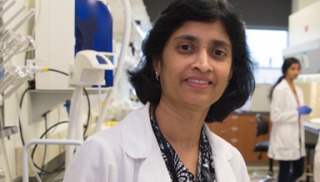Coppin Researcher Contributes to Study that May Offer Early Diagnostic for Age-Related Eye Disease

A new study co-authored by a Coppin State University professor has revealed a potentially new early diagnostic option for discovering degenerative eye disease in its earliest stages.
Dr. Kavita Hegde, CSU associate professor of biology in the department of natural sciences, has co-authored a study published in SPIE, The International Society for Optics and Photonics’ Journal of Biomedical Optics (JBO). The study’s initial indications show that the use of tetracycline-family antibiotics may play a role in diagnosing degenerative eye disease in its earliest stages, which is sooner than current diagnostics. Hegde is part of a team of researchers that includes scientists from University of Maryland School of Medicine and a researcher from Queen’s University Belfast, Belfast, UK.
Age-related macular degeneration (AMD) is the leading cause of severe, permanent vision loss in people over age 60. It happens when the small central portion of the retina, called the macula wears down. The eye disease gets worse over time. On average, it takes about 10 years to move from diagnosis to legal blindness. Early detection can allow earlier treatment and increases the chances of preserving vision.
According to Hegde, tiny deposits of lipids, proteins and minerals, sometimes known as drusen can collect under the retina. Those deposits may indicate a risk for developing AMD. Tetracycline-family antibiotics commonly used to treat a variety of infections, are known for having a side effect of staining teeth and bones. The study suggests the staining effect of Tetracycline-family of antibiotics makes those sub-retina minerals visible under fluorescence lifetime imaging microscopy (FLIM), which leads to detection in earlier stages than current detection methods.
“The implications of this initial research finding are exciting because they may open possibilities for diagnostics and early stage prevention. However, much more study needs to conducted for eventual clinical use,” Hegde said.
The article authors are: Henryk Szmacinski, Department of Biochemistry and Molecular Biology, University of Maryland School of Medicine, Baltimore, Maryland; Kavita Hegde, Department of Natural Sciences, Coppin State University, Baltimore, Maryland; Hui-Hui Zeng, Department of Biochemistry and Molecular Biology, University of Maryland School of Medicine; Katayoun Eslami, Department of Biochemistry and Molecular Biology, University of Maryland School of Medicine; Adam Puche, Department of Anatomy and Neuroscience, University of Maryland School of Medicine; Imre Lengyel, Wellcome Wolfson Institute for Experimental Medicine, School of Medicine, Dentistry and Biomedical Science, Queen's University Belfast, Belfast, UK; and Richard B. Thompson, Department of Biochemistry and Molecular Biology, University of Maryland School of Medicine.



